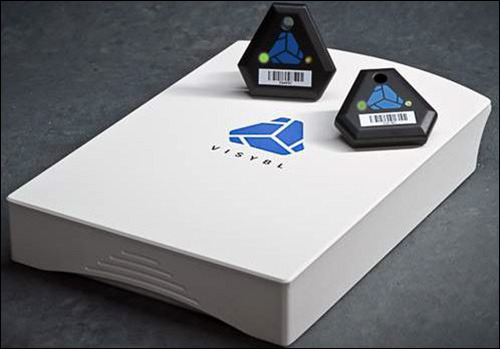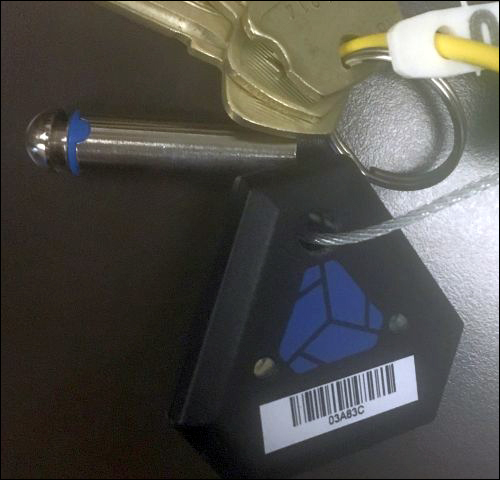Pennsylvania’s Mount Airy Casino Resort is employing Bluetooth Low Energy (BLE) beacons to ensure that it automatically knows if any of its keys leave the premises, thereby enabling it to meet regulatory standards by never allowing a single key to venture away from the casino. The system—sold by Baltimore technology company Barcoding Inc. and built and installed by enterprise beacon start-up Visybl—consists of AssetBeacons attached to keys, a single CloudNode beacon reader mounted above the employee exit, light stacks (installed at the door and in the security communications office) and a cloud service to prompt an alert and the dissemination of messages to management in the event it determines that a key might be about to leave the premises.
The system does more than identify keys that might be going out the door, however. When Lianne Asbury, Mount Airy Casino Resort’s director of security, uses the Visybl app on her iPhone, she can also view the proximity of any nearby keys inside the casino.

Mount Airy Casino Resort, like all other casinos in the commonwealth state, must follow stringent rules dictated by the Pennsylvania Gaming Control Board, one of which is that keys for the casino’s security, slot machines, table games and main cage departments never leave the premises. The casino could be subject to fines of $5,000 or more for each incident of an employee inadvertently taking a key out of the building. “Key security is critical to us,” Asbury states.
To help prevent such an infraction, the casino utilizes a Traka key-management system. Every key is attached to a key ring fitted with a Traka iFob, which contains a contact (non-RFID) memory chip encoded with a unique 48-bit ID number. The key rings are stored within locked cabinets, with each ring’s iFob plugged into a jack, thus enabling the system to read the ID encoded to its memory. To unlock the cabinet, an employee swipes his or her ID card and inputs the ID number of the key ring he or she is taking. If that individual is authorized to remove that key ring, the system sets a curfew—typically, eight hours from the time that the ring and its key (or keys) are removed. If that person is not authorized to do so, however, the system will sound an alert if the worker attempts to remove those keys from the cabinet. If the ring key has not been returned by the start of the curfew, an e-mail message is sent to the casino’s management.
However, Asbury notes, the shortcoming to this system is that by the time the curfew has been reached, the key could be long gone from the facility. As the casino has been hiring more employees, who carry keys around the building for the four departments, it has become increasingly common for a key to be inadvertently removed (for instance, if an employee brings it to the parking lot during a cigarette break).
Asbury explained her predicament to Barcoding Inc., which began considering solutions, says Tom O’Boyle, Barcoding Inc.’s RFID director. The problem with passive RFID tags, he explains, is that the technology could not guarantee a 100 percent read rate due to the large size of the doorway’s opening, or if an employee had a tagged key in a pocket or purse. Barcoding Inc. has been testing beacon technology from Visybl for the past year, O’Boyle says, and the firm and Mount Airy agreed that the beacons would work well for this application.
Visybl, a Maryland-based startup, was launched in 2015 by PV Subramanian, formerly the senior product manager at Zebra Technologies. He says he founded the company to meet a perceived need for BLE solutions. While working for Zebra, Subramanian recalls, he noticed that mobile-based asset-management systems were all moving from Microsoft Windows Mobile operating systems to iOS- and Android-based apps, and both Android and iOS devices come with BLE capabilities. Nearly everyone has an Android or iOS device, he says, adding that consequently, “Everyone should be saying, ‘I have a sensor gateway in my pocket.'”

Visybl visited Mount Airy Casino Resort, installed a CloudNode reader above the employee door and attached battery-powered beacons to 280 of the casino’s most critical keys. The triangular beacon tags measure approximately 2 inches square.
The casino faced a unique challenge, Subramanian says, in that the locked cabinets in which keys are stored are located only about 20 feet from the egress where Mount Airy wanted to prevent the keys’ potential exit. Therefore, Visybl adjusted not only the beacons’ power level, but also the CloudNode reader’s sensitivity, in order to accommodate the cabinet’s close proximity to the doorway. In addition, although the CloudNode can still read the beacon tags within the locked cabinet, the software’s algorithms are set to ignore those transmissions until they come within about 15 feet of the exit door where the reader is installed.
The system was taken live in July 2016. When an employee needs a key, he or she still uses the Traka system to access it, creating a record of which key was removed. Now, however, the key has a beacon tag attached to it that transmits a unique identifier every few seconds, linked to that key’s description in the Visybl cloud-based software.
Once the reader comes within approximately 15 feet of the CloudNode, it identifies that beacon transmission and forwards the data to the software. The software then prompts two light stacks to begin flashing: one at the employee door and one in the security communications office, where a worker is stationed 24 hours a day. If the employee with the key sees the light, he or she can step away from the door and place the key in the locked cabinet. If that individual were to continue through the door while still possessing the key, an audible alarm would sound and an e-mail would be sent to the department managers onsite, as well as to Asbury.
The audible alert would go silent after about 15 seconds. However, the light stacks would continue to flash red until a manager acknowledges the alert message.
Additionally, the system consists of a Visybl app that is downloaded on Asbury’s iPhone, enabling her to use her own phone as a secondary beacon reader. The app can capture transmissions from the key beacons when they are within about 100 feet, depending on the exact location. That means, for instance, that while she is walking the casino floor, she can use the app to identify where a specific key is located, gain reassurance that it is also on the floor and determine its distance from the phone.
The system has proven to educate managers regarding how often keys may be approaching the doorways, even if the individual in possession of them simply intends to briefly step outside the facility. (Mount Airy’s standard procedure is for personnel to place the key in the locked cabinet anytime an employee steps outside, even for a moment.)
When the system was first installed, Asbury says, numerous flashing-light alerts were triggered, typically because an employee was about to take a break outside and forgot that he or she still had the key. “It was a transition of getting used to the system,” she recalls. “We had instances of people going out to the food truck [for example] and setting off the alarm.” Those alerts continue to this day, she notes, and are serving the purpose of preventing potential violations for the casino.
During the past two months since the system was installed, Asbury reports, no keys have been removed from the facility. She attributes this to the effectiveness of the solution that Visybl installed.


